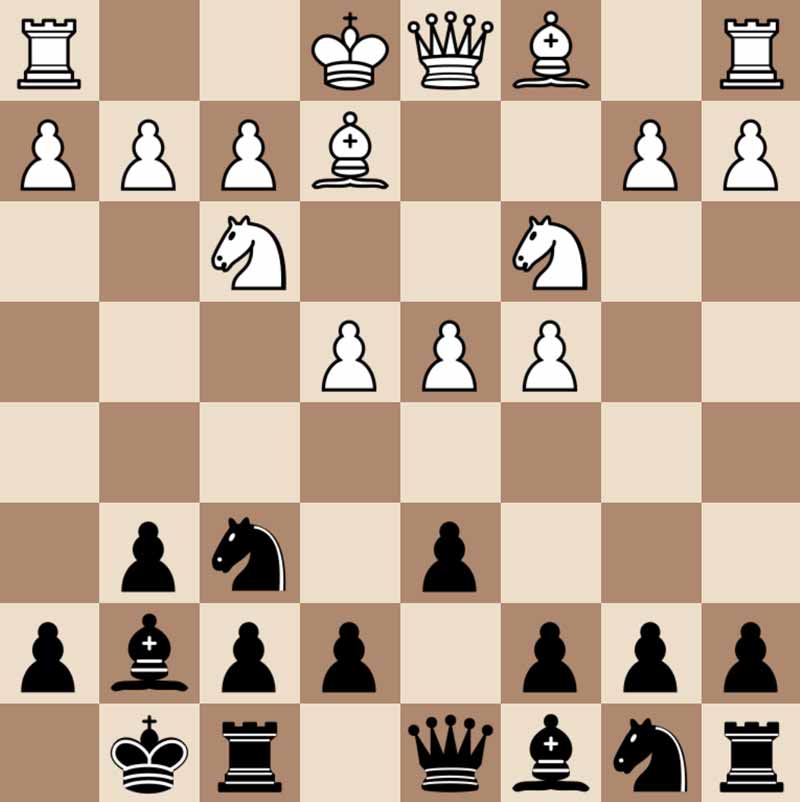One of the most fighting lines against 1.d4 is the King’s Indian Defence. It’s a very big system, where Black has more than one way to play. Two of the most common ones in them arise after they play 6…c5 or 6…e5.
Which one is a better continuation?
In this article, we will find out the answer to it. You’ll see the basic variations in both the lines and understand the typical ideas in it. Also, you’ll see what our verdict is on both the lines.
In the end, we will compare them and give you our recommendation.
Before we start, let us clarify one thing. We will be talking about the King’s Indian Defence Classical Variation after
And here
6…c5
6…e5
With both the moves, Black is exerting direct pressure on White’s centre. However, the arising structures are very different and the plans that need to be formulated are different too. Let’s have a look at both of these moves carefully –
6…c5
After this move, Black has to be prepared to play either Benoni-like structures or the Maroczy bind.
White has two main continuation after this –
1 – 7.0-0
This is the most popular choice. After
7…cxd4
The structure resembles the Maroczy bind setup. Objectively speaking, the position is equal and Black should have no problems here. But, you need to be acquainted with the typical methods of playing this position.
Another main continuation for White is
2 – 7.d5
In this case, Black responds either with 7…e6 or 7…e5. After
7…e6
The game often continues
8.0-0 exd5 9.cxd5 Re8!
And this leads to typical Benoni structures. The main plan here for Black is to combine pressure in the centre with that on the queenside. The fianchetto Bg7 and the rook on e8 are very powerful pieces here.
Black can play …Bg4, exchange their bishop for the knight and later launch queenside play with …Na6-Nc7 and …b5. Objectively speaking, Black is fine.
Final Verdict – For playing c5 on the sixth move is that you need to be well-acquainted with the Benoni and the Maroczy-bind Structure. Also expect the play to be more positional and solid here, compared to 6…e5.
6…e5
If you want to go by popularity and aggression, 6…e5 is the clear winner. Thanks to the e5-pawn, Black can launch a kingside attack with much ease compared to c5. This leads to typical King’s Indian positions where –
- Black wants to attack on the kingside.
- White wants to crush on the queenside.
White’s most popular option in this line is –
7.0-0
Here, the mainline continues with
7…Nc6 8.d5 Ne7 9.Ne1
White is preparing to bring the knight to d3 to launch a queenside attack. Black on the other hand continues to build up on the kingside.
9…Nd7 10.Be3 f5 11.f3 f4 12.Bf2 g5 13.Rc1
And now, both sides are primed up for action. Black wants to checkmate the White king. They have attacking numerous plans at their disposal. One of them is to go 13…Rf6 and Rh6, followed by …Qe8 and Qh5, with pressure along the h-file.
Another plan is to …Nf6, …Ng6 followed by g4 at the right time. We’ve covered the typical tactics that arise due to this plan in another article.
Black should be careful of White’s play on the queenside. In the end, it all comes down to who is faster on which side. If you love attacking play, this line is what you should go for in the KID.
There are also other lines here for Black that don’t involve a kingside attack. They include moves like …c6, …Nbd7, …a5 where the play is focussed in the centre. Black has reasonable chances there as well.
Final Verdict – If you love attacking play, then 6…e5 is the line you must go for. Be prepared for some sharp tactical battles where you’ll get a lot of opportunities to sacrifice pieces and checkmate the White king.
Conclusion
So whether to play 6…c5 or 6…e5 in the King’s Indian, comes down to your style. Both of them are objectively fine.
If you prefer positional lines in an opening like KID, go for 6…c5.
On the other hand, if you want to play aggressive chess, in the true spirit of the opening, then 6…e5 is the line for you.Also a good idea is to play both the lines from time to time. This way, you’ll not only gain more experience in them but also your opponent’s will have a tougher challenge to prepare against you.


